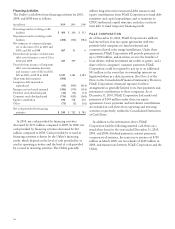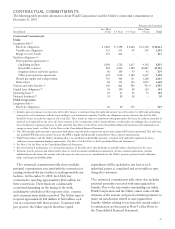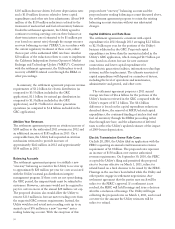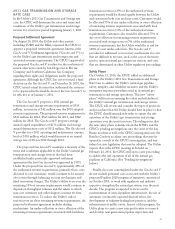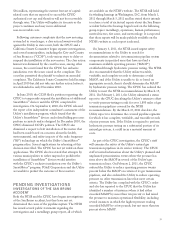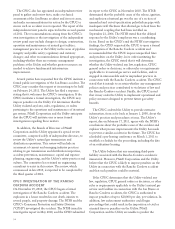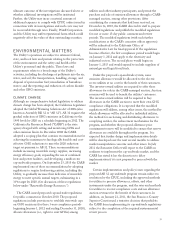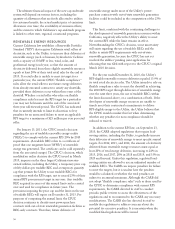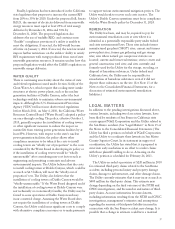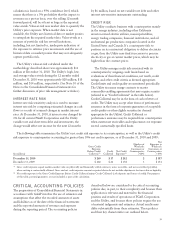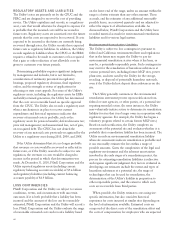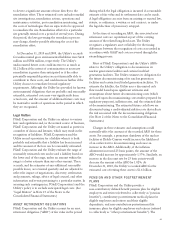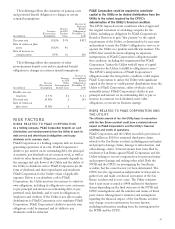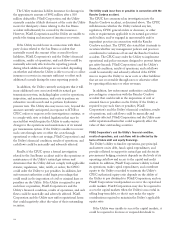PG&E 2010 Annual Report Download - page 40
Download and view the complete annual report
Please find page 40 of the 2010 PG&E annual report below. You can navigate through the pages in the report by either clicking on the pages listed below, or by using the keyword search tool below to find specific information within the annual report.The ultimate financial impact of the new cap-and-trade
system will depend on various factors, including the
quantity of allowances that are freely allocated to utilities
for customer benefit; the actual market price of emissions
allowances over time; the availability of emission offsets;
and the extent to which California’s cap-and-trade program
is linked to other state, regional, or national programs.
RENEWABLE ENERGY RESOURCES
Current California law establishes a Renewable Portfolio
Standard (“RPS”) that requires California retail sellers of
electricity, such as the Utility, to increase their deliveries of
renewable energy (such as biomass, hydroelectric facilities
with a capacity of 30 MW or less, wind, solar, and
geothermal energy) each year, so that the amount of
electricity delivered from these eligible renewable resources
equals at least 20% of their total retail sales by the end of
2010. If a retail seller is unable to meet its target for a
particular year, the current CPUC “flexible compliance”
rules allow the retail seller to use future energy deliveries
from already-executed contracts to satisfy any shortfalls,
provided those deliveries occur within three years of the
shortfall. Whether a retail seller who relies on flexible
compliance rules has met the RPS target for a particular
year may not be known until the end of the associated
three-year roll-forward period. The CPUC has indicated
that it currently intends to limit its discretion to levy
penalties for an unexcused failure to meet an applicable
RPS target to a maximum of $25 million per year per retail
seller.
On January 13, 2011, the CPUC issued a decision
regarding the use of tradable renewable energy credits
(“RECs”) to comply with the current RPS 20% by 2010
requirements. (A tradable REC refers to a certificate of
proof that one megawatt-hour (“MWh”) of renewable
energy was generated. The certificate can be sold separately
from the associated energy.) The CPUC’s decision, which
modified an earlier decision the CPUC issued in March
2010, imposes on the three largest California investor-
owned utilities, including the Utility, a temporary price cap
of fifty dollars per tradable REC and a temporary quantity
cap that permits the Utility to use tradable RECs for
compliance with the RPS target, not to exceed 25% of their
annual RPS procurement target in any year. Any tradable
REC acquired in excess of this annual limit can be carried
over and used for compliance in future years. The
provisions imposing the price cap and the limit on the use
of tradable RECs will expire on December 31, 2013. For
purposes of computing the annual limit, the CPUC
decision continues to classify most power-purchase
contracts with out-of-state renewable generation facilities as
REC-only contracts. Therefore, future deliveries of
renewable energy under most of the Utility’s power-
purchase contracts with out-of-state renewable generation
facilities could be included in the computation of the 25%
limit.
This limit, combined with the continuing challenges to
the development of renewable generation resources within
California, negatively affects the Utility’s ability to meet
the current RPS while the limit remains in effect.
Notwithstanding the CPUC’s decision, some uncertainty
still exists regarding the use of tradable RECs and the
ability to satisfy RPS requirements with out-of-state
renewable generation, because the CPUC has not yet
resolved the utilities’ pending joint application for
rehearing that was filed with respect to the CPUC’s original
March 2010 decision.
For the year ended December 31, 2010, the Utility’s
RPS-eligible renewable resource deliveries equaled 15.9% of
its total retail electricity sales. The Utility intends to rely on
flexible compliance rules to meet the shortfall in achieving
the 2010 RPS target through deliveries of renewable energy
over the next three years, the use of tradable RECs within
the limit discussed above, or a combination of both. If the
developers of renewable energy resources are unable to
timely meet their contractual commitments to deliver
RPS-eligible energy to the Utility, the Utility believes that
the CPUC would consider this fact when determining
whether any penalties for non-compliance should be
reduced or waived.
In addition to the current RPS law, on September 23,
2010, the CARB adopted regulations that require load-
serving entities, including the Utility, to gradually increase
their deliveries of renewable energy to meet specific annual
targets. For 2012, 2013, and 2014, the amount of electricity
delivered from renewable energy resources must equal at
least 20% of total energy deliveries, increasing to 24% in
2015, 2016, and 2017, 28% in 2018 and 2019, and 33% in
2020 and beyond. Under this regulation, regulated load-
serving entities are allowed to use an unlimited number of
tradable RECs. The CARB can impose penalties for failure
to meet the targets, but it is unclear how the penalties
would be calculated or whether the total penalties are
subject to an annual maximum. Although the CARB did
not adopt “flexible compliance rules” such as those used by
the CPUC to determine compliance with current RPS
requirements, the CARB directed its staff to conduct
periodic public reviews to assess the effectiveness of the
regulations and to recommend to the CARB any necessary
modifications. The CARB also has directed its staff to
modify the regulations to address concerns about the
potential for excessive penalties. It is uncertain when the
modified final regulations will be issued.
36


